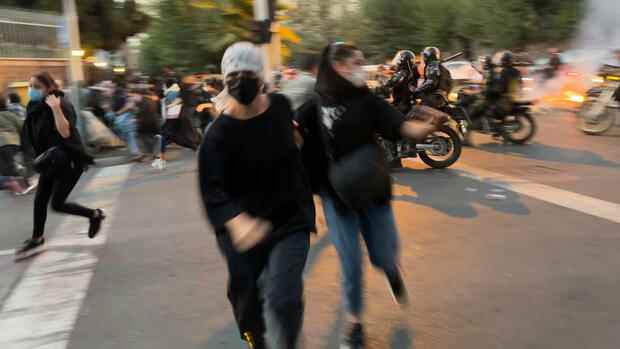Berlin The protests in Iran are becoming increasingly violent. At least 50 people have died in the clashes between demonstrators and security forces, according to Iranian media. Protests have continued in dozens of cities since 22-year-old student Mahsa Amini died in Tehran on September 13.
The young Kurd came to the capital with her family and was arrested there by the vice squad. She wore her headscarf too loosely and her hair was visible, which is a violation of Islamic regulations in the theocracy.
There are two conflicting stories about how Amini died. Amini was hit against the window of a police vehicle when she was arrested, resulting in a fractured skull. She had succumbed to her fatal cerebral hemorrhage and had already been taken to a hospital, lifeless. A corresponding tweet from the clinic has since been deleted.
Police deny hurting the student. She died of a heart attack. Her father, Amjad Amini, says his daughter was perfectly healthy.
Top jobs of the day
Find the best jobs now and
be notified by email.
The day after the young Kurd’s funeral in her hometown of Saghez on the Saturday before last, protests began in the Kurdish part of Iran and then spread. Thousands of Iranians have been demonstrating against the regime across the country at night time and again, despite the brutal actions of the security forces.
The death of a young woman who broke the dress code sparked the protests.
(Photo: AP)
It began with slogans such as “Woman, Life, Freedom” against the headscarf requirement, and now more and more posters can be seen against the powerful religious and revolutionary leader Ayatollah Ali Khamenei. “Death to the dictator!” shout the demonstrators.
“This determination and women in the front row has never existed before,” Iran expert Ali Fatholla-Nejad from Freie Universität Berlin told Handelsblatt. The political scientist sees a real chance for change in Iran.
The protest movement is completely different from previous ones: multi-ethnic, a joint protest of the poor as well as the middle class and especially women. That’s why, according to Fatholla-Nejad, it’s impossible to predict whether the mass demonstrations will end in a bloodbath like all the previous ones, or in a new revolution.
The regime is “insecure,” says Fatholla-Nejad. Because the women knew that there would be no voluntary abolition of the compulsory hijab. “The hijab, the headscarf, is one of the immovable pillars on which the Islamic Republic stands” and cannot be abolished without the regime collapsing. And the protesters also knew that there could be no reform of the regime, only the abolition of the Islamic Republic.
>> Read here: Unrest in Iran – is the Mullah regime now faltering?
The prominent women’s rights activist and researcher Mansoureh Shojaee sees a turning point in the protests: “After 40 years under the rule of a misogynist establishment, this movement is chanting the most feminine and civilized slogan that unites women and men from Tehran to Kurdistan.”
Iranians living abroad are also showing solidarity with the protests.
(Photo: IMAGO/ZUMA Press)
The current demonstrations and the public burning of headscarves are “the culmination of years of protest movement in Iran – especially the past five years – and are aimed at the pinnacle of power”.
In addition to the headscarf requirement, Iranians are also protesting about ever-increasing inflation, unemployment and the unresolved consequences of natural disasters. The economic problems are partly due to the tough sanctions imposed by the US over the Iranian nuclear program, but also due to corruption and mismanagement.
Iran’s president warns of ‘acts of chaos’ at demonstrations
What is missing is an organized opposition capable of leading a coup. Many potential leaders have been arrested as a precautionary measure or have been under house arrest since 2009. At that time there was a “green” revolt against the election fraud of the then President Mahmoud Ahmadinejad.
The last time there were violent protests in 2019 was a sudden increase in the state-set price of petrol. Hundreds of people died in the weeks of rioting.
Even now, the police, moral police and above all the Islamist fanatic Bassij militias are taking relentless action against protesters. And now the head of the powerful Iranian judiciary is demanding a deadly crackdown on the protests “without forbearance”.
Gholamhossein Mohseni-Ejei wrote on the official online portal of the judiciary, Mizan Online, on Sunday. However, some in the regime, such as Parliament leader Mohammed Bagher Ghalibaf, are calling for the vice police’s crackdown to be softened. The head of Tehran’s moral police has already been deposed. Despite this, the police continue to shoot at demonstrators.
More: Iran’s judiciary plans special courts for demonstrators – Baerbock calls for new sanctions
